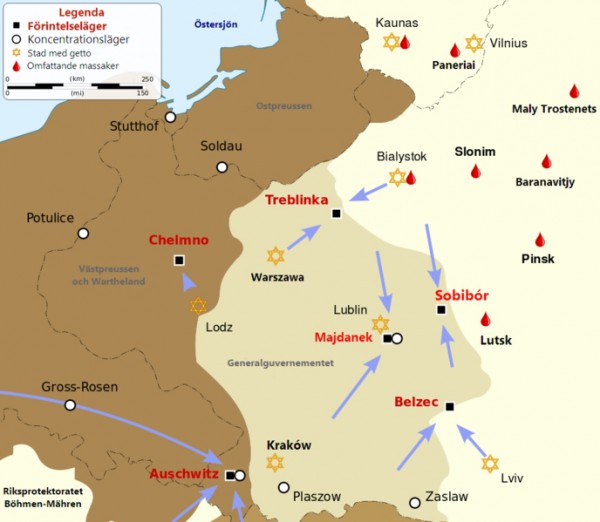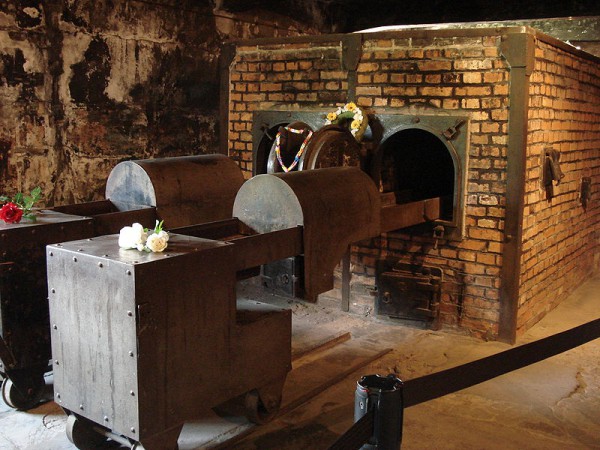“The LORD comforts His people and will have compassion on His afflicted ones.” (Isaiah 49:13)
Today is International Holocaust Remembrance Day.
It is also the anniversary of the liberation of the Auschwitz concentration camps at the end of World War II.
On January 27, 1945, the Soviets entered this complex of camps, which included a concentration, extermination and forced labor camp, liberating more than 7,000 prisoners, most of whom were sick or dying.
Only 7,000 were left in the camp because the Nazis killed thousands in a fevered frenzy as the Soviets approached.
Then they began evacuating Auschwitz, forcing nearly 60,000 prisoners, mostly Jews, on a Death March in the cold of winter. The marching prisoners suffered from starvation and exposure, and anyone who fell behind was shot. Over half died.
Of the estimated 1.3 million people—at minimum—who were deported to Auschwitz between 1940 and 1945, at least 1.1 million were murdered. (ushmm)

Russian Jewish men await selection at Auschwitz, the largest camp established by the Germans. After disembarking from the trains, being sent to the right meant forced labor. Being sent to the left meant death in the gas chambers. This camp was located 37 miles (60 km) west of Krakow, near the prewar German-Polish border.
Remembering Holocaust Victims
“The LORD will surely comfort Zion and will look with compassion on all her ruins.” (Isaiah 51:3)
Today, Auschwitz remains a memorial to the millions whose lives were lost there.

A Holocaust survivor lights a torch at Yad Vashem (The Holocaust Martyrs’ and Heroes’ Remembrance Authority). Six torches are lit on Israel’s Holocaust Remembrance Day in memory of the six million Jews who were murdered in the Holocaust. (Photo: Isaac Harari / Yad Vashem)
Auschwitz was an industrialized killing machine that took the lives of nearly 6,000 people a day, and the camp claimed the lives of over a million Jews through mass exterminations, starvation, infectious diseases, individual executions, and medical experiments.
Half of the symbol appears as the star worn by Jews during the Holocaust. The other half reflects the strong lines of the star on Israel’s national flag.

In November 1939, the Nazi government first introduced mandatory ID badges for Jews in Poland. The yellow badge was considered to be one step in the Final Solution as it enabled them to isolate the Jews. To enforce compliance, they announced, “Severe punishment is in store for Jews who do not wear the yellow badge on back and front.” (Jewish Virtual Library)
Holocaust Survivors in Israel
About 160,000 Holocaust survivors live in the state of Israel today.
They were children during the Second World War, who experienced persecution, deportation, selection, forced labor, hunger, torture and the loss of families.
Following the war, they came to Israel IN FULFILLMENT OF BIBLICAL PROPHECY (Ezekiel chapter 37’s vision of Dry Bones), and tried to live normal lives. However, not all were able to.
For many, even 70 years after the war, the emotional scars are unmistakable.

People were stripped of their identity when they entered the camps, and a number was tattooed on their arm.
A significant number of survivors still suffer the effects of the trauma they experienced during the Holocaust.
Others were able to cover up their feelings for years, only to be confronted with them later when they were less busy with their work.
The result can be anxiety, depression, and other disorders.
As well, Holocaust survivors tend to be more vulnerable to the Arab-Israeli military tensions that exist in Israel.
Stress can bring latent anxieties to the surface. Unfortunately, even in Israel the welfare and health services lack sufficient resources to deal with this problem.
“At least one Holocaust survivor an hour is dying in Israel and we are getting very close to the point where there will be no more first-hand accounts left,” Daniels said. “The onus falls on us, not just as Jews and Israelis, but humanity as a whole, to learn, to be with the survivors and to understand what happened and to ensure it never repeats again.” (From the Depths)

Jewish women are forced to disrobe and pose for the camera before being killed at the mass murder of 2,749 Jews on the beach near the city of Liepāja, in Latvia, on December 15 through 17, 1941.
How the Nazi Killing Machines Developed
Typically, victims were forced from their homes and herded into railway cattle cars.
Initially, however, the Germans used killing groups called Einsatzgruppen (task forces) to round up and massacre entire Jewish communities.
Rivka Yosselevska, who testified at the trial of Adolph Eichmann in 1961, was one of a few who survived the Nazi massacre of 500 Zagrodzki ghetto Jews (near Pinsk in Belarus) in August 1942.
Yosselevska lost her daughter, mother, father and sister, as well as other relatives in the slaughter.
She said her daughter had asked her when they we were lined up in the ghetto, “Mother, why did you make me wear the Shabbat dress; we are being taken to be shot.”

Adolph Eichmann showed no remorse during his trial and said he was simply following orders. “The world now understands the concept of ‘desk murderer.’ We know that one doesn’t need to be fanatical, sadistic, or mentally ill to murder millions; that it is enough to be a loyal follower eager to do one’s duty,” wrote Simon Wiesenthal in Justice, Not Vengeance.
At the mass grave, she asked, “Mother, why are we waiting? Let us run!”
Yosselevska said, “Some of the young people tried to run, but they were caught immediately, and they were shot right there. It was difficult to hold on to the children…. The suffering of the children was difficult; we all trudged along to come nearer to the place and to come nearer to the end of the torture of the children.” (Jewish currents)
Although Yosselevska was shot in the head, she lived. For three days, she lay among the dead.
The farmer who found her, hid and fed her.
He also helped her to join a group of Jews hiding in the forest where she managed to survive until the Soviet army arrived in 1944.
Eventually, the Nazis decided that shooting as a method of mass killing was too expensive and inefficient. It required killing to be done one bullet at a time. And it demoralized the troops.

A visitor to Auschwitz carries the Israeli flag as a group examines a boxcar used to transport Jews to extermination and concentration camps.
The Wannsee Conference Decides the Final Solution
In 1942, Nazi Party officials met near Berlin at the Wannsee Conference to discuss the “Final Solution” for the destruction of European Jewry.
There they coordinated the deportation of Europe’s Jews to extermination camps that were already operating or were under construction in German-occupied Poland.
As many as 11 million Jews were to be transported to these killing centers, including residents of countries not then under Nazi control, such as Ireland, Sweden, Turkey, and Great Britain. (ushmm)
They decided that the mass transportation of these populations would be accomplished by train.

Selection of Jews at the Judenrampe (Jewish ramp) in Auschwitz-II (Birkenau) German Nazi death camp, May/June 1944.
The SS and the police coordinated with local auxiliaries or collaborators in occupied territories to round up the victims and transport them to the death centers.
In charge of all this was SS Lieutenant Colonel Adolf Eichmann, who was later to meet his demise at the end of a rope in an Israeli prison.
To disguise their intentions, Nazi authorities referred to these deportations as “resettlements” to labor camps in the “East.” In reality, they were killing centers for mass murder.

During 1943 and 1944, the killing center at Auschwitz-Birkenau played a central role in the planned destruction of European Jewry. Transports arrived on a regular schedule from every German-occupied country of Europe—from as far north as Norway to the Greek island of Rhodes off the coast of Turkey in the south, from the French slopes of the Pyrenees in the west to the easternmost reaches of German-occupied Poland and the Baltic states. (ushmm)
Maus: Journeys Through the Holocaust
In his comic book, “Maus II,” Art Spiegelman described his father’s experiences during the Holocaust.
Spiegelman depicted how his father and hundreds of other prisoners were loaded onto a Nazi train.
“It was such a train for horses, for cows,” his father says. “They pushed until it was no room left. We lay one on top of the other, like matches, like herrings. I pushed to a corner not to get crushed.”
Spiegelman’s father used the thin blanket he had received as a prisoner to create a hammock using hooks in the ceiling, climbing up on the shoulders of other inmates to reach it.
“In this way I can rest and breathe a little. This saved me. Maybe 25 people came out alive from this car of 200,” he states.
He goes on to describe how the train suddenly stopped. They stood sealed in the boxcars for days and nights on end without food or water.
There was no room to fall. And if someone did, the others stood on them. One inmate used a knife to try to free himself from those standing on him, but died anyway.
Spiegelman’s father survived by reaching through the window and grabbing snow from the roof. He traded it for sugar, saving his life and theirs.
The train remained sealed for a week.
When his boxcar was finally opened, he saw that they were surrounded by other trains with boxcars that were never opened, everyone inside dying. Then the car was resealed and continued on toward Dachau. Those who were inside continued to die, and many went mad.

Most Jews who were deported to the death camps were executed upon arrival. A small number of prisoners were selected and kept alive to perform the necessary work in the camps. Killing centers were set up in German-occupied Poland at Chelmno, Belzec, Sobibor, and Auschwitz-Birkenau (left side of the map). This map does not show all extermination and concentration camps. The drops of red on the map are places where Jews were massacred, and the stars indicate cities where the Jewish People were confined to tightly packed ghettos.
Blaming Those We Harm: When Will Jews Be Forgiven for the Holocaust?
In spite of the numerous eyewitness accounts to the horrendous events that took place during the Holocaust, many today still deny its very existence.

By early spring 1943 in Auschwitz II, four huge crematoria housed eight gas chambers and 46 ovens, which could dispose of about 4,400 corpses per day. (PBS)
The loss of six million Jewish people in the Holocaust confirms that when anti-Semitism festers, the ultimate result can be catastrophic.
Today, as global anti-Semitism rises (hatred toward the Jewish People and Israel), we must go beyond solemn moments of remembrance and speak out against anti-Semitism.
We must never forget those who suffered during the Holocaust.
For the sake of the Jewish People and all people everywhere, we must never forget what happened so that it will never happen again.



















